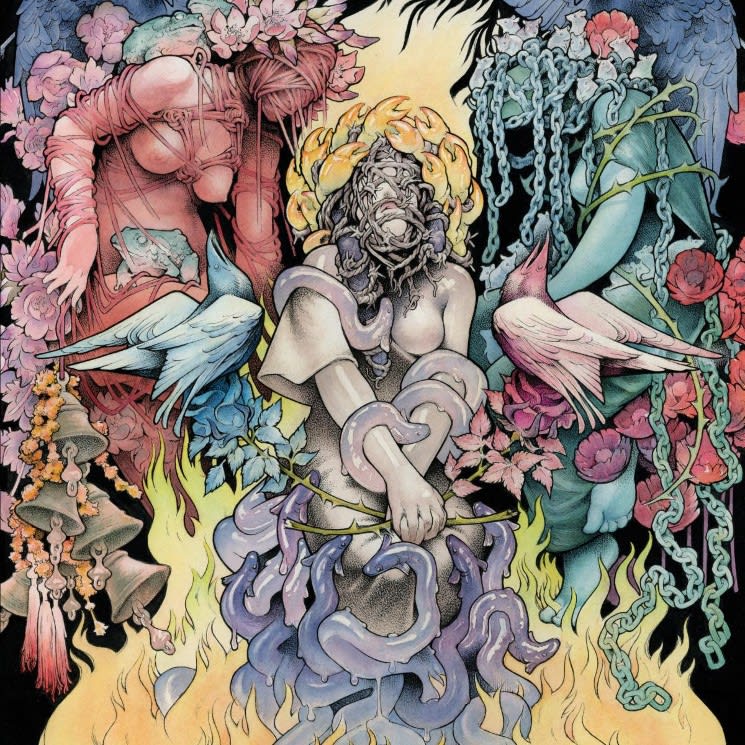Since their first true full-length release, 2007's Red Album, Baroness have been trying to mutate their primal sound. The sludgy, progressive metal band's records all exist in the same connecting universe, based on the mythologic artwork of band leader John Baizley and the chromatic colour wheel. Yet with every release, the music always arrives somewhat altered from what came before — when put up against counterparts like Mastodon or High on Fire, Baroness are one of the most interesting and gratifying bands to follow in metal.
Even 20 years into their career, Baroness are still dipping into the obscure. Either by new mixing techniques, layered-instrumentation, punishing drum fills or wild gang vocals, the band is never satisfied sitting still; their songs live in a different realm of the constantly-expanding genre of metal.
Which brings us to their latest offering, STONE (which ditches the colour wheel naming methodology and represents a new era for the band.) Self-produced and recorded in an Airbnb by Baizley, STONE corrects the mistakes of Gold & Grey — often an over-mixed and muddied record that only really sounded crisp on the most expensive headphones — by shining a light on their layered guitar work, trembling bass riffs and war-cry vocals.
STONE sounds majestic as all hell, on any type of speaker. Songs like "Last Word" are impressively complex and diverse, with heavy-as-ever but oh-so-accessible riffery and twisting Diary of a Madman-esque solos from lead guitarist Gina Gleason, who also doubles as backing vocalist.
Baizley and Gleason's vocals are now much more comfortable with each other, cutting through like lacerating steel on "Beneath the Rose" — which boasts one of the heaviest outros in Baroness' career — or leaning dark and droney on the gorgeous folk duet intro of "Magnolia."
That juxtaposition might be STONE's strongest asset. Instances of blood-thirsty fuzzed out prog metal riffs are slotted next to easygoing acoustic strums on a song like "Anodyne," a ballad about drowning, with Gleason and Baizley's harmonies tying each disparate piece together.
In the past, Baroness have opted for longer albums, with 2012's Yellow & Green being a whopping 18 songs. Some of those songs were interludes, but they tended not to add much to the full listening experience. In STONE's case every song, be it an interlude like "Embers" or the two part death march "Choir" and "The Dirge," is needed. It's one of their most streamlined and focused records yet.
(Abraxan Hymns)Even 20 years into their career, Baroness are still dipping into the obscure. Either by new mixing techniques, layered-instrumentation, punishing drum fills or wild gang vocals, the band is never satisfied sitting still; their songs live in a different realm of the constantly-expanding genre of metal.
Which brings us to their latest offering, STONE (which ditches the colour wheel naming methodology and represents a new era for the band.) Self-produced and recorded in an Airbnb by Baizley, STONE corrects the mistakes of Gold & Grey — often an over-mixed and muddied record that only really sounded crisp on the most expensive headphones — by shining a light on their layered guitar work, trembling bass riffs and war-cry vocals.
STONE sounds majestic as all hell, on any type of speaker. Songs like "Last Word" are impressively complex and diverse, with heavy-as-ever but oh-so-accessible riffery and twisting Diary of a Madman-esque solos from lead guitarist Gina Gleason, who also doubles as backing vocalist.
Baizley and Gleason's vocals are now much more comfortable with each other, cutting through like lacerating steel on "Beneath the Rose" — which boasts one of the heaviest outros in Baroness' career — or leaning dark and droney on the gorgeous folk duet intro of "Magnolia."
That juxtaposition might be STONE's strongest asset. Instances of blood-thirsty fuzzed out prog metal riffs are slotted next to easygoing acoustic strums on a song like "Anodyne," a ballad about drowning, with Gleason and Baizley's harmonies tying each disparate piece together.
In the past, Baroness have opted for longer albums, with 2012's Yellow & Green being a whopping 18 songs. Some of those songs were interludes, but they tended not to add much to the full listening experience. In STONE's case every song, be it an interlude like "Embers" or the two part death march "Choir" and "The Dirge," is needed. It's one of their most streamlined and focused records yet.
